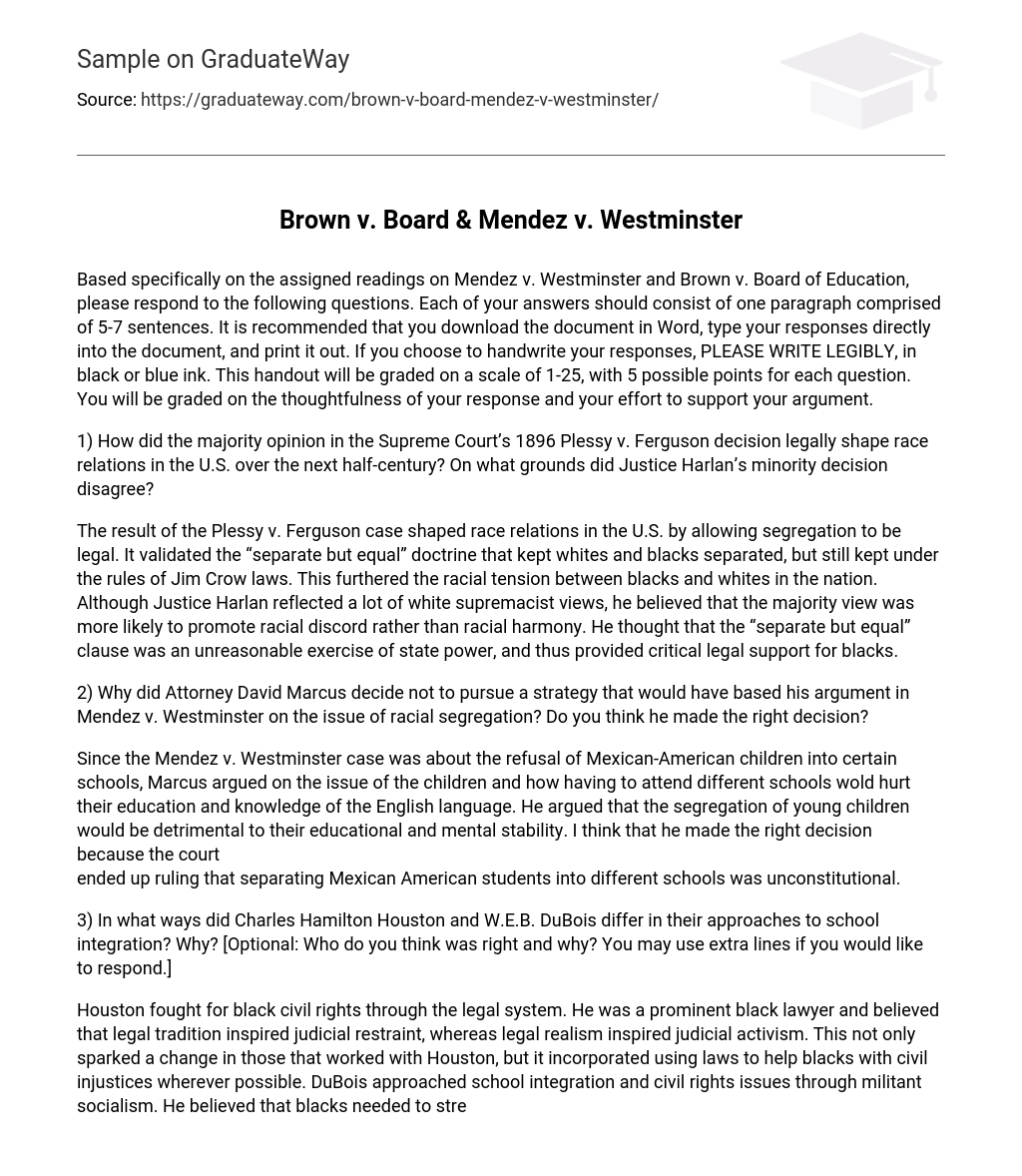The suggested format for answering the questions is to use a paragraph structure. The assigned readings on Mendez v. Westminster and Brown v. Board of Education should be referenced in your responses. It is recommended to download the document in Word, type your answers directly into it, and print it out for clarity purposes. In case you decide to write by hand, please do so using either black or blue ink. Furthermore, this handout will be graded on a scale of 1-25, with each question carrying 5 points. Your overall grade will depend on the depth of your response and the effort put forth in presenting supporting arguments.
In the U.S., race relations were greatly influenced by the Supreme Court’s 1896 Plessy v. Ferguson ruling for the following half-century, according to the majority opinion. In addition, Justice Harlan’s minority decision provided arguments against this.
The Plessy v. Ferguson case had a profound effect on race relations in the United States by legalizing segregation and supporting the “separate but equal” principle, which enforced the separation of whites and blacks under Jim Crow laws. This ruling intensified the racial division between these two groups. Despite Justice Harlan’s white supremacist views, he acknowledged that the majority decision would likely exacerbate racial tensions rather than promoting harmony. He saw the provision for “separate but equal” as an unfair use of state power, thus providing crucial legal support to black individuals.
2) Attorney David Marcus chose not to base his argument in Mendez v. Westminster on the grounds of racial segregation. The decision made by Marcus is debatable in terms of its correctness.
The Mendez v. Westminster case dealt with the exclusion of Mexican-American children from specific schools. Marcus presented an argument emphasizing the negative impact on the children’s education and English language proficiency caused by attending separate schools. He contended that segregating young students would harm their learning and mental well-being. In my opinion, his decision was justified as the court ultimately declared the separation of Mexican-American students into different schools as unconstitutional.
3) How did Charles Hamilton Houston and W.E.B. DuBois differ in their approaches to school integration? Why? [Optional: Who do you think was right and why? You may use extra lines if you would like to respond.]
Houston, a prominent black attorney, advocated for black civil rights within the legal system. He believed that by combining judicial restraint and activism, he could bring about change inspired by legal tradition and realism. Houston’s efforts not only influenced his colleagues but also highlighted the importance of utilizing laws to address civil injustices faced by black individuals. Conversely, DuBois supported school integration and civil rights through militant socialism, urging blacks to strengthen their own infrastructure for a better social structure. However, this approach was met with disapproval from the NAACP. In my opinion, Houston’s method of school integration was more widely accepted as it did not offend as many people compared to DuBois’ suggestion that blacks needed to initiate change within their community to gain acceptance in society.
4) The Supreme Court made rulings on Sweatt v. Painter and McLaurin v. Oklahoma State Regents in 1950, while also ruling on Brown v. Board of Education in the same year. What were the notable distinctions between the two 1950 cases and Brown v. Board?
The Sweatt v. Painter case showed that the previous “separate but equal” doctrine, acknowledged in the Plessy v. Ferguson case, was unattainable in state-funded higher education. In a separate case, McLaurin v. Oklahoma State Regents reversed a lower court’s decision that would have required African American students to graduate while being segregated. However, the Brown v. Board case differed from these cases by declaring all racially segregated public schools unconstitutional instead of focusing on just one university. As a result, this case had a more significant impact on history compared to the other two cases.
Both the Mendez v. Westminster and Brown v. Board of Education cases involved the interpretation of the Fourteenth Amendment in their court hearings. While Mendez v. Westminster was resolved in a federal district court, Brown v. Board of Education made its way to the U.S. Supreme Court. Consequently, these decisions prompted a reassessment of the proper understanding of the Fourteenth Amendment.
Both Mendez v. Westminster and Brown v. Board challenged the unconstitutional segregation of students in public schools by reinterpreting the Fourteenth Amendment, achieving significant transformations in the American public school system. However, their focuses differed – Mendez v. Westminster centered on Mexican-Americans while Brown v. Board addressed African Americans. Additionally, Mendez v. Westminster specifically targeted elementary school students whereas Brown v. Board applied to all public schools.





